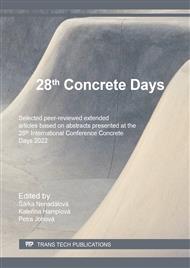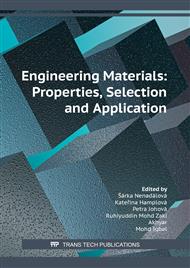[1]
P. Koteš, J. Vičan, Reliability-based evaluation of existing concrete bridges in Slovakia according to Eurocodes. The Fourth International fib Congress 2014, Mumbai, Improving Performance of Concrete Structures,, Proceedings, Mumbai, India, © IMC-FIB, 2014 (2014) 227-229.
DOI: 10.1016/j.proeng.2012.07.082
Google Scholar
[2]
P. Koteš, J. Vičan, Recommended reliability levels for the evaluation of existing bridges according to Eurocodes. Structural Engineering International, 23(4), (2013) 411-417.
DOI: 10.2749/101686613x13627351081678
Google Scholar
[3]
P. Koteš, J. Prokop, M. Strieška, J. Vičan, Calibration of partial safety factors according to Eurocodes. 26th R-S-P Seminar 2017 Theoretical Foundation of Civil Engineering, Warsaw, Poland, MATEC Web of Conferences, 117: art. no 00088,.
DOI: 10.1051/matecconf/201711700088
Google Scholar
[4]
Z. Kala, Global Sensitivity Analysis of Reliability of Structural Bridge System. Engineering Structures, 194 (2019) 36-45.
DOI: 10.1016/j.engstruct.2019.05.045
Google Scholar
[5]
Z. Kala, Sensitivity Analysis in Probabilistic Structural Design: A Comparison of Selected Techniques. Sustainability, 12(11), (2020) 4788. https://doi.org/10.3390/su12114788.
DOI: 10.3390/su12114788
Google Scholar
[6]
M. Moravcik, P. Bujnakova, F. Bahleda, Failure and damage of a first-generation precast prestressed bridge in Slovakia. Structural Concrete, 21(6), (2020) 2352-2362.
DOI: 10.1002/suco.201900526
Google Scholar
[7]
J. Odrobiňák, J. Gocál, J. Jošt, NSS test of structural steel corrosion. Roczniki Inżynierii Budowlanej (Annals of Construction Engineering), Polish Academy of Science, Territorial Branch Katowice, 15 (2017) 7-14.
Google Scholar
[8]
J. Odrobiňák, R. Hlinka, Degradation of steel footbridges with neglected inspection and maintenance. Bridges in Danube Basin 2016, Procedia Engineering, Elsevier, 156 (2016) 304-311.
DOI: 10.1016/j.proeng.2016.08.301
Google Scholar
[9]
STN EN 1992-2 Eurocode 2 Design of concrete structures. Part 2: Concrete bridges – Design and detailing rules. Slovak office of Standards, Metrology and Testing (2007).
DOI: 10.3403/30096437
Google Scholar
[10]
P. Ryjaček, M. Macho, V. Stančík, M. Polák, The Deterioration and assessment of steel bridges. Proceedings of the 8th International Conference on Bridge Maintenance, Safety and Management, IABMAS 2016 (2016) 1188-1195.
DOI: 10.1201/9781315207681-181
Google Scholar
[11]
M. Macho, P. Ryjaček, The impact of the severe corrosion on the structural behavior of steel bridge members. Advances and Trends in Engineering Sciences and Technologies - Proceedings of the International Conference on Engineering Sciences and Technologies, ESaT 2015 (2015) 23-128.
DOI: 10.1201/b19249-25
Google Scholar
[12]
I. Hollý, J. Bilčík, K. Gajdošová, Numerical modelling of reinforcement corrosion on bond behaviour. International Multidisciplinary Scientific GeoConference Surveying Geology and Mining Ecology Management, SGEM, 249 (2016) 191-196.
DOI: 10.4028/www.scientific.net/ssp.249.191
Google Scholar
[13]
V. Krivy, M. Kubzova, K. Kreislova, V. Urban, Characterization of corrosion products on weathering steel bridges influenced by chloride deposition, Metals 2017, 7(336), (2017).
DOI: 10.3390/met7090336
Google Scholar
[14]
M. Krejsa, L. Koubova, J. Flodr, J. Protivinsky, Q.T. Nguyen, Probabilistic prediction of fatigue damage based on linear fracture mechanics. Frattura ed Integrita Strutturale (Fracture and Structural Integrity). 11, 39(249), (2017) 143-159.
DOI: 10.3221/igf-esis.39.15
Google Scholar
[15]
T. Bobalo, Y. Blikharskyy, N. Kopiika, M. Volynets, Serviceability of RC Beams Reinforced with High Strength Rebar's and Steel Plate, in Proceedings of advances in resource-saving technologies and materials in civil and environmental engineering (CEE 2019),, Lecture Notes in Civil Engineering, Vol. 47 (2020) 25-33.
DOI: 10.1007/978-3-030-27011-7_4
Google Scholar
[16]
K. Bacharz, W. Raczkiewicz, M. Bacharz, W. Grzmil, Manufacturing Errors of Concrete Cover as a Reason of Reinforcement Corrosion in a Precast Element-Case Study, in Coatings, 9(11), (2019) 702.
DOI: 10.3390/coatings9110702
Google Scholar
[17]
J. Prokop, J. Vican, Comparison of beam-column resistance according to European Standards, in 13th International scientific conference on sustainable, modern and safe transport (Transcom 2019),, Transportation Research Procedia, Vol. 40 (2019) 883-890.
DOI: 10.1016/j.trpro.2019.07.124
Google Scholar
[18]
S. Rehacek, P. Hunka, D. Citek, J. Kolisko, I. Simunek, Impact resistance of fiber-reinforced concrete, in Advanced Materials Research, vol. 1054 (2014) 48-53.
DOI: 10.4028/www.scientific.net/amr.1106.225
Google Scholar
[19]
J. Kral'ovanec, F. Bahleda, P. Prokop, M. Moravcik, M. Neslusan, Verification of Actual Prestressing in Existing Pre-Tensioned Members. Applied Sciences-Basel, 11(13) (2021) 5971.
DOI: 10.3390/app11135971
Google Scholar
[20]
M. Neslusan, F. Bahleda, K. Trojan, M. Pitonak, K. Zgutova, Barkhausen noise emission in over-stressed steel wires. Journal of Magnetism and Magnetic Materials, 513 (2020) 167134.
DOI: 10.1016/j.jmmm.2020.167134
Google Scholar
[21]
Y. Blikharskyy, R. Khmil, Z. Blikharskyy, Research of RC columns strengthened by carbon FRP under loading, in The 3rd Scientific conference environmental challenges in civil engineering (ECCE 2018),, MATEC Web of Conferences, 174 (2018) 04017.
DOI: 10.1051/matecconf/201817404017
Google Scholar
[22]
J. Selejdak, Y. Blikharskyy, R. Khmil, Z. Blikharskyy, Calculation of Reinforced Concrete Columns Strengthened by CFRP, in Proceedings of advances in resource-saving technologies and materials in civil and environmental engineering (CEE 2019),, 17th International Scientific Conference on Current Issues of Civil and Environmental Engineering Lviv- Kosice - Rzeszow (CEE), Lecture Notes in Civil Engineering, 47 (2020) 400-410.
DOI: 10.1007/978-3-030-27011-7_51
Google Scholar



